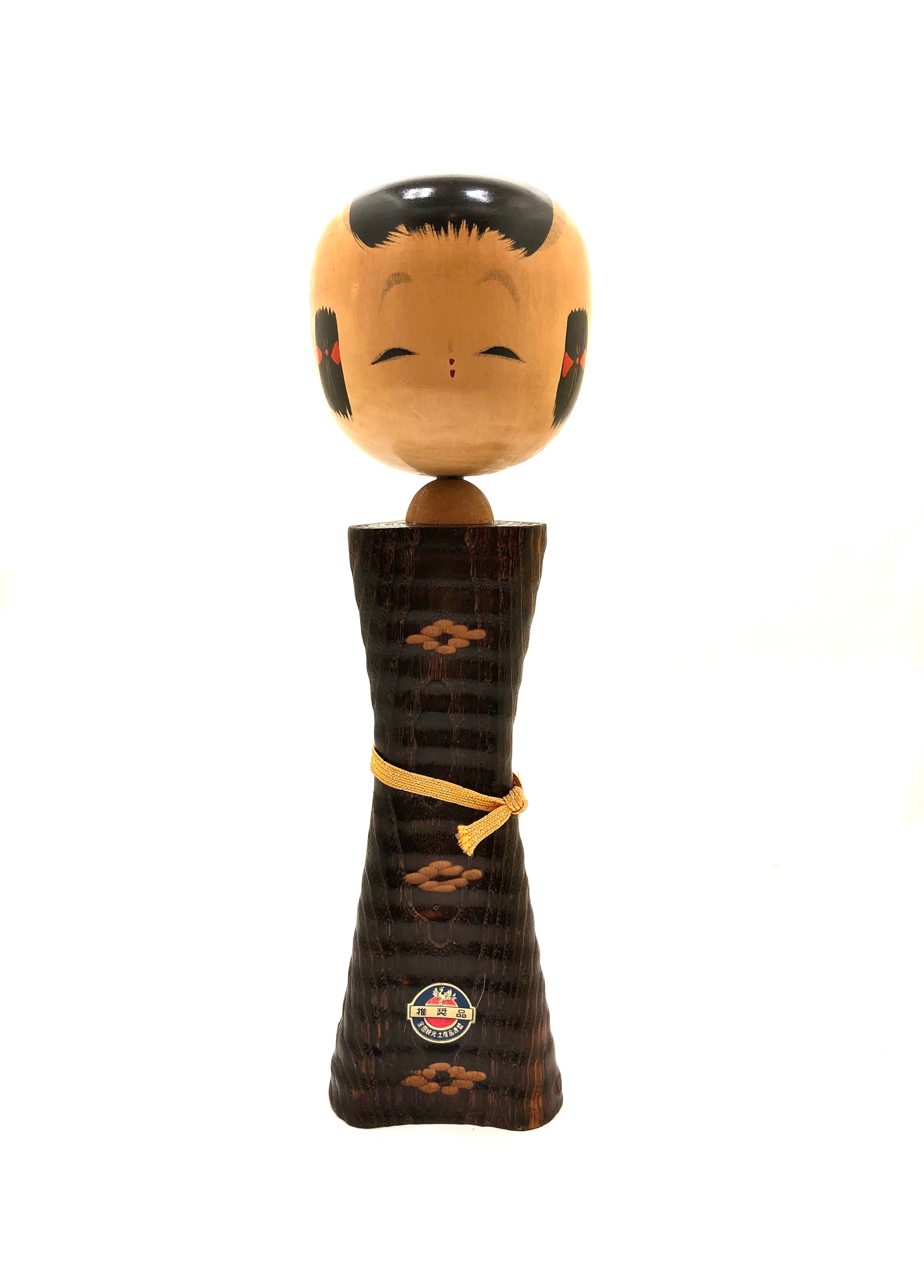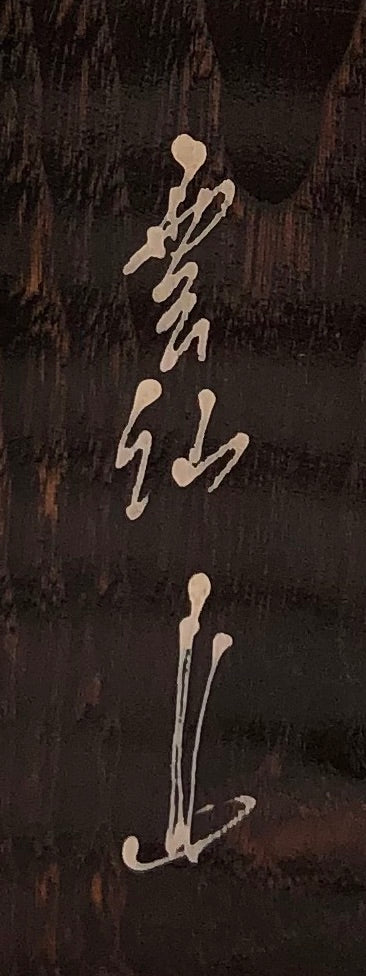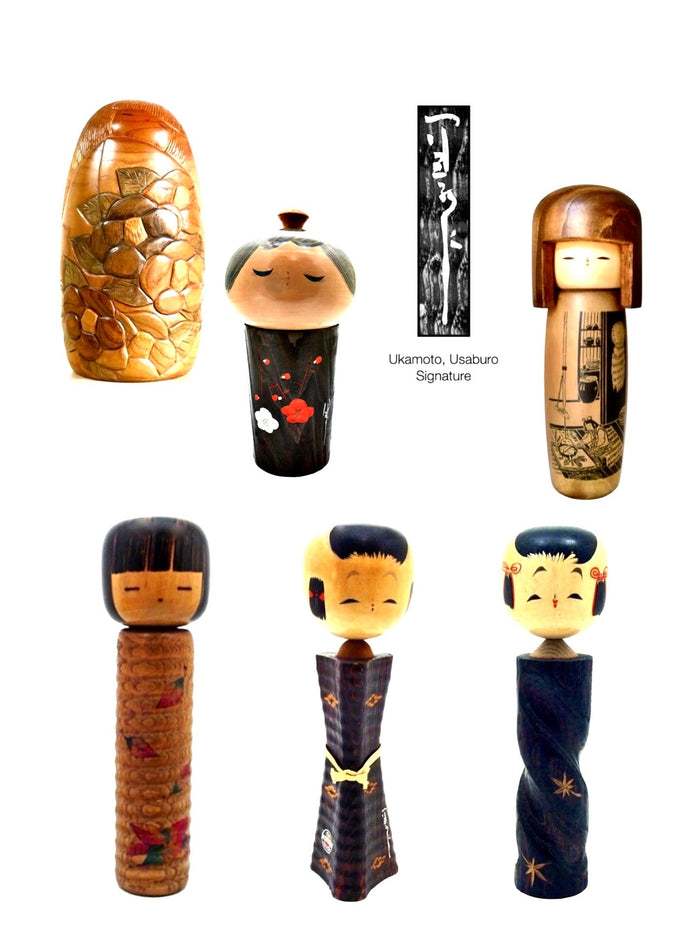


Vintage Transitional Sosaku Kokeshi by Okamoto, Usaburo Entitled: “Hitoe-obi / Sash”
Dimensions: 12-0”h
This piece has a unique and unusual triangular form body and created early in Usaburo’s career. The neck and head are lathe-turned and raised from the body, and the remaining form is hand-carved to give it its shape and character. The head has a traditional hair design evoking the Buddha bun, and tied and drapes down the back of the head. The face is the traditional element showing black hair fringes framing the face and decorated with hair bows. It shows a suggestion of eyebrows, thin narrow eyes, and two red dots representing the nose and mouth. An abstract Cherry blossom motif has been carved into the body, with a tied sash, (hitoe-obi, simple summer cord) acting as the obi and evokes the Buddhist conception of eternity and perhaps a reference to Acala, a divinity who tied demons to protect humans.
This doll is made of Paulownia wood and is treated using the "yakisugi" technique, a slight burn on the surface, an ancestral technique intended to protect against fire. A true collector's piece of historic Usaburo and authorities claim this doll is a forerunner to his machine-made dolls with the combination of the traditionally designed head and the contemporary carved body is the basis for the piece being categorized as “Transitional”. The paper seal is the confirmation of the award won on this doll. The piece is his signature using white ink on the back.
Vintage Condition: Original condition with no flaws, no scratches, no dents, or missing elements. The photos support the description.
NOTE: Usaburo, (1917-2009) was the patriarch of the most prolific family of Creative Kokeshi doll craftsmen. Okamoto-san began creating Sosaku dolls in 1950. Winner of many awards, including the Prime Minister’s Award. He was hampered by past techniques and ideas of Kokeshi-making. Usaburo introduced special machines for producing Kokeshi and adopted a method of carving and buying using Nichrome wire in the Kokeshi painting process, for which only brushes had been used before. Usaburo also studied the possibility of using kayak and chestnut, trees having beautiful grains, in addition to table dogwood, a commonly used material. He established a museum in Gunma, which his sons and daughters, and extended family now maintain.

Artisan
Woodworker: Okamoto, Usaburo
1917-2009
Biographical History:
Okamoto-san was born in Shinto Village, Gunma Prefecture in 1917. Usaburo was the patriarch of the most prolific family of Modern Kokeshi doll manufacturing and began creating Sosaku dolls in 1950. He developed a technique of carving and baking to prevent wood from cracking and established the prototype for the Usaburo Kokeshi doll's introduction into the Kokeshi world. Winner of many awards, including the Prime Minister’s Award, his early dolls were mostly hand-carved/painted on the wheel and one which was cherished was his Kokeshi Container for personal items in which the head being a separate element formed the top of the cylindrical container. His masterpiece, “Kantsubaki (Camellia in the Winter)”, featured his favorite camellia flower on a beautiful zelkova for the bodies and Mizuki which was purchased by Emperor Showa. He established a museum in Gunma and passed away at the age of 91, and his sons, daughters, and extended family have currently been creating what is called “character” dolls, souvenirs decorations, and children’s toys.
Collector's note – descriptive qualities, standard characteristics & ornamentation styles:
Some of Okamoto’s lathe-turned dolls typically incorporate ribbing of the natural wood to give depth and textural quality. Many doll heads are traditional in appearance and painterly in execution. He is also known to twist the form of the body for interest. He incorporates many seasonal motifs such as cherry blossoms, falling leaves, wheat, persimmons, and the crane and dragonfly, (tonbo).
Explore & Learn More about Woodworker: Okamoto, Usaburo